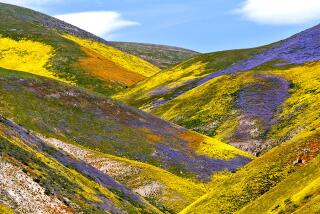Asters Fill Gap Between Summer, Winter Blooms
After summer flowers have faded and before winter bloomers appear, asters light up the garden with their cheery, daisy-like flowers. Native to temperate regions in the Northern Hemisphere, they grow well in our mild Southern California weather.
“Although asters come in a wide range of colors and sizes and are vigorous growers, they are uncommon in many gardens,” says John Whittlesey, owner of Canyon Creek Nursery in Oroville, a mail-order company that specializes in uncommon perennials, including more than 20 perennial aster varieties.
Asters range in size from small, 6-inch-high mounding bedding plants to 6-foot-tall giants that can grow several feet wide. Flower colors include white, blue, lavender, yellow, pink and purple.
Some of Whittlesey’s favorites include ‘Bill’s Big Blue,’ which grows to 5 feet and 3 feet across. This makes a great cut flower with its sturdy, erect stems topped with long sprays of medium-blue flowers.
A. pringlei ‘Monte Casino’ was developed for use as a cut flower in Holland. It grows 4 to 5 feet tall and has airy sprays of white flowers resembling baby’s breath that are used as filler in bouquets.
A. Cordifolius ‘Little Carlow’ will tolerate partial shade. The 3- to 4-foot-high plant has dark violet-blue flowers. A. lateriflorus ‘Prince’ has deep purple leaves during the summer and is covered with mauve-pink flowers in the fall.
Now is a good time to transplant asters, many of which will bloom into November. Keep the following planting tips in mind:
* Plant most asters in full sun. A few varieties tolerate some shade, such as the divaricatus and cordifolius types. When deciding on a location, keep in mind that asters are dormant during the winter months.
* Place asters in an area where they will receive regular water. If the area is a dry one, amend with 25% compost to improve the soil’s water-holding capacity. Plant at the same height as the asters are in their container. When planting several, place them 24 to 30 inches apart.
* Asters do well in containers. Use at least a 12-inch pot, high-quality potting soil and a slow-release fertilizer.
* Keep asters well-watered but not soggy.
* Fertilize ground-grown asters monthly with an all-purpose fertilizer during their growth period, which is generally March through November.
* Don’t prune asters during their active growth period, especially in summer. It won’t improve their bloom, and may even cause fewer flowers come fall.
* Shelter plants from strong Santa Ana winds, which can cause damage. Staking taller types may be necessary.
* Asters are generally pest- and disease-free, although you may occasionally have powdery mildew in the late fall. The best prevention is to avoid overhead watering.
* When they finish flowering, asters go dormant. Cut them down to the ground at this point, leaving a small amount of basal foliage, which will stay during the winter months. Come March or April, the plant will grow again.
* Divide asters every two or three years in February or March or they will lose their vitality. To divide, dig the plants up and select the strongest pieces, eliminating any older, woody sections. Replant them in the same location.
Canyon Creek Nursery, 3527 Dry Creek Road, Oroville, CA 95965. (530) 533-2166. Catalog $2.
(BEGIN TEXT OF INFOBOX / INFOGRAPHIC)
NOVEMBER / Planting Aster (Compositae -- Perennials -- All zones)
There are more than 600 species of true asters. They come in a wide range of colors and sizes, from 6 inches to 6 feet high. Now is a good time to transplant asters, many of which will bloom into this month. Here are planting guidelines.
Transplant at the same height as original pot.
Keep soil moist.
Asters need regular watering. If the soil is dry, amed it with 25% compost to improve its water-holding capacity. When planting several asters, place them 24 to 30 inches apart.






